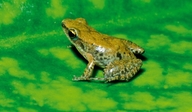|
Wakea madinika (Vences, Andreone, Glaw & Mattioli, 2002)
| family: Mantellidae subfamily: Mantellinae genus: Wakea |
| Species Description: Vences M, Andreone F, Glaw F, and Mattioli F. 2002. New dwarf species of Mantidactylus from northwestern Madagascar (Anura: Mantellidae). Copeia 2002: 1057–1062. | |
 © 2008 Miguel Vences and Frank Glaw (1 of 1) |
|
|
|
Description Blommersia species are generally similar, but at least slightly larger and with different relative finger length (Glaw and Vences 2007). Distribution and Habitat Country distribution from AmphibiaWeb's database: Madagascar
Life History, Abundance, Activity, and Special Behaviors Calls: Feeble chirps of one male were heard at night (Glaw and Vences 2007). Trends and Threats Possible reasons for amphibian decline General habitat alteration and loss Comments
References
Andreone, F. and Vences, M. (2008). Wakea madinika. In: IUCN 2008. 2008 IUCN Red List of Threatened Species. www.iucnredlist.org. Downloaded on 21 April 2009. Glaw, F., and Vences, M. (2007). Field Guide to the Amphibians and Reptiles of Madagascar. Third Edition. Vences and Glaw Verlag, Köln. Originally submitted by: Miguel Vences and Frank Glaw (first posted 2009-04-21) Description by: Michelle S. Koo (updated 2021-06-07)
Edited by: Kellie Whittaker, Michelle S. Koo (2021-06-07) Species Account Citation: AmphibiaWeb 2021 Wakea madinika <https://amphibiaweb.org/species/6063> University of California, Berkeley, CA, USA. Accessed May 29, 2025.
Feedback or comments about this page.
Citation: AmphibiaWeb. 2025. <https://amphibiaweb.org> University of California, Berkeley, CA, USA. Accessed 29 May 2025. AmphibiaWeb's policy on data use. |



 Map of Life
Map of Life